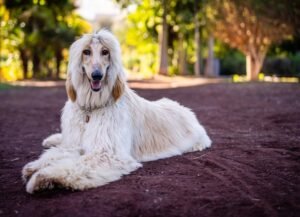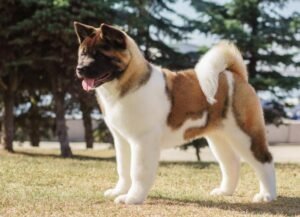What’s an Aussiedoodle? Sometimes called an Aussiepoo, the Aussiedoodle is a cross between an Australian Shepherd and a Poodle, resulting in a fluffy and charismatic dog. Breeders started producing Aussiedoodles in the 1990s along with several other popular Poodle crosses such as Goldendoodles, Cockapoos, and Labradoodles. When full-grown, Miniature Aussiedoodles (an Aussie and Miniature Poodle mix) can weigh up to 30 pounds, while the standard size can grow to be 70 pounds.
Like their parent breeds, Aussiedoodles can be a wide range of colors, from jet black to blue merle. And while Poodles are popular for their non-shedding curls, Australian Shepherds are moderate shedders. There’s no guarantee that your Aussiedoodle will be a light shedder, and while they might be a good fit for some people with allergies, no dog breed is completely hypoallergenic. If you’re allergic to dogs, spend time with the breed before bringing home an Aussiedoodle puppy to see how you react.
Caring for an Aussiedoodle
Both Poodles and Australian Shepherds are smart dogs, so it makes sense that Aussiedoodles would be intelligent as well. Their big brains make them highly trainable, and well-trained Aussiedoodles are generally friendly with everyone they meet.
When you bring home an Aussiedoodle puppy, you’re signing yourself up for a regular workout regimen. These active dogs need playtime and long walks every day, especially if they take after their highly energetic Australian Shepherd parent. Their favorite activities include playing fetch, running, and swimming (Poodles are water dogs, after all). Aussiedoodles need at least an hour of movement every day.
Aussiedoodle Health Issues
As a crossbreed, an Aussiedoodle can be affected by genetic conditions common in both Poodles and Australian Shepherds. A dog’s health often depends on the breeding, so prospective pet parents looking to purchase from an Aussiedoodle breeder need to do their due diligence and find an ethical breeder who screens the health of their dogs.
Thyroid Disease
The most common genetic condition in Australian Shepherds is thyroid disease, according to the Australian Shepherd Club of America. Autoimmune thyroiditis is the most common cause of hypothyroidism in dogs. Common symptoms include unexplained weight gain, skin problems, and heat-seeking behavior. If you notice any of these signs, take your Aussiedoodle to the veterinarian. Luckily, the disease can be treated with inexpensive and readily available medication.
Sebaceous Adenitis
One of the more common health problems affecting Poodles is sebaceous adenitis, a type of inflammatory skin disease, according to the Poodle Club of America. The disorder causes inflammation of the glands that lubricate the skin and hair, causing scaling, flaking, and hair loss. There is no cure for sebaceous adenitis, but the symptoms can be managed with routine baths and ointments.
Joint Dysplasia
Like many medium and large dog breeds, Aussiedoodles can be affected by hip dysplasia and elbow dysplasia. Dysplasia is caused by a malformed joint. This can cause pain and, if untreated, arthritis. Mild cases can be treated with exercise, a healthy diet, and maintaining a healthy weight. However, more severe cases of dysplasia might require surgery.
Bloat
Large and deep-chested breeds like Poodles are predisposed to bloat. If this develops into gastric-dilation volvulus, or GDV—where a dog’s stomach fills with air and twists—it can be fatal. Like their Poodle parent, standard Aussiedoodles may be predisposed to bloat.
Signs of bloat include:
Bloat and GDV are serious conditions. If you notice any symptoms, take your dog to the vet immediately.
What To Feed an Aussiedoodle
Like any active dog breed, Aussiedoodles need a well-balanced diet that gives them the energy they need to play and grow. When choosing a food, pet parents should look for options approved by the Association of American Feed Control Officials (AAFCO).
To support growth, Aussiedoodle puppies should eat a food designed specifically for the puppy life stage. Once they reach their first birthday, they can be switched to adult dog food.
How To Feed an Aussiedoodle
Full-grown Aussiedoodles should be fed two meals a day. Aussiedoodle puppies need to eat more frequently—between three and four times a day on a consistent schedule.
To minimize risk of bloat, Aussiedoodle pet parents must make sure their dog doesn’t ingest too much food or water too quickly. If your pup tends to wolf down her meals, consider using a slow-feeder bowl, which makes it difficult for her to devour a meal in large bites. Avoiding raised dog bowls and exercise around mealtimes can also help deter bloat.
How Much Should You Feed an Aussiedoodle?
How much you feed your Aussiedoodle depends on the dog’s size, age, and overall health. The dog food packaging will give guidance on how much to feed your dog based on weight, but speaking to your veterinarian about portions is the best way to keep your pup healthy.
Nutritional Tips for an Aussiedoodle
Active dogs need food that meets all of the nutritional needs set out by the Pet Food Institute. Aussiedoodles’ ideal diets include vitamins like Vitamin A and D3, as well as proteins and fats. Vitamin A helps protect a dog’s vision and boosts their immune system, while D3 helps maintain strong bones. Proteins help your Aussiedoodle create the energy she needs for running and playing, and fats help her keep her wavy coat healthy.
Behavior and Training Tips for Aussiedoodles
Aussiedoodle Personality and Temperament
Aussiedoodles are generally friendly and loving dogs that, when well socialized, get along with other pets and children. Each Aussiedoodle’s energy level can vary. Those that take after their Australian Shepherd side may need more activity than those who lean toward the Poodle parent.
Both breeds, however, are extremely intelligent and need ample stimulation to keep them from getting bored. Aussiedoodle parents can try teaching fun tricks to keep their canine friend’s mind active while also building their relationship. Puzzle toys or treat containers that require dogs to figure out how to access snacks are also a good option.
Aussiedoodle Behavior
Australian Shepherds were bred to herd, and Poodles have hunted waterfowl for centuries. Put these hardworking breeds together and you’ve got a high-energy, highly intelligent dog that needs to keep their mind busy. Those not given enough stimulation can turn to destructive behaviors, like chewing or digging.
Because of their hunting and herding instincts, Aussiedoodles must be kept on a leash or inside a fenced-in area when they’re outside. Otherwise, they might chase after neighborhood animals—or even cars.
Aussiedoodle Training
Aussiedoodles love to play and to have a task to accomplish. Their quick-working brains might enjoy clicker training and, once they’ve mastered basic cues, learning more complicated tricks.
Teaching your Aussiedoodle to stay, and come when called, is vital for pet parents. Otherwise, their strong herding instincts and urge to chase can put them in dangerous situations.
Fun Activities for Aussiedoodles
-
Agility courses
-
Lure chasing
-
Hunting and retrieving
-
Therapy work
-
Dock jumping
-
Swimming
Aussiedoodle Grooming Guide
An Aussiedoodle’s beautiful coat takes extra care compared to short-haired dog breeds. Their coats can be tightly curled or wavy, but all textures require regular grooming and trims to keep them looking their best.
Skin Care
Aussiedoodle parents need to keep an eye out for symptoms of sebaceous adenitis, one of the most common genetic conditions in Poodles. Consult a vet if you notice excessive flaking, scaling, or thickening of the skin. Otherwise, Aussiedoodles should be bathed as needed to keep them clean and smelling fresh.
Coat Care
Each Aussiedoodle’s coat is different, so each dog’s grooming routine will look different. Aussiedoodles with a curlier coat might require more frequent trims and brushing than those that take more after their Australian Shepherd lineage. Using a slicker brush can help reduce mats and tangles in dogs with longer hair.
Eye Care
Other than wiping gunk from their dog’s eyes and surrounding hair, Aussiedoodles don’t require a ton of attention to their eyes. Make sure their fur is trimmed so it doesn’t block their vision, and contact your veterinarian if you notice changes in or around the eyes.
Ear Care
Poodles adore swimming, and your Aussiedoodle might inherit their water-loving nature. Pet parents need to clean their dog’s ears with a dog-specific cleaner after their dog takes a dip (and after baths, too). This will help prevent moisture from becoming trapped, which can lead to ear infections.
Considerations for Pet Parents
Because Aussiedoodles are generally friendly dogs, they can make a great pet for anyone who has the time to train and exercise them. Aussiedoodles can be energetic—especially Ausiedoodle puppies—and need at least an hour of exercise and stimulation a day. Aussiedoodles with the strong herding instinct of Australian Shepherds need a yard with a tall fence and to be walked on a leash if they cannot control their urge to chase.
Prospective Aussiedoodle parents should make sure they have time in their schedule and space in their home for their new friend to play. And remember: Due to their longer coats, Aussiedoodles require more grooming than short-haired dogs.
Aussiedoodle FAQs
How big do Aussiedoodles get?
When full-grown, Miniature Aussiedoodles can weigh up to 30 pounds, while the standard size can grow to be 70 pounds.
How long do Aussiedoodles live?
The life expectancy for an Aussiedoodle is between 10-12 years.
How much do Aussiedoodles cost?
Aussiedoodle puppies can cost anywhere between $500-$5,000, depending on the breeder and location.
Are Aussiedoodles good family dogs?
Aussiedoodles are loyal, friendly dogs who enjoy training. As long as your Aussiedoodle is well-trained, they can be an excellent addition to the family.
Featured Image: iStock/Steve Bruckmann




